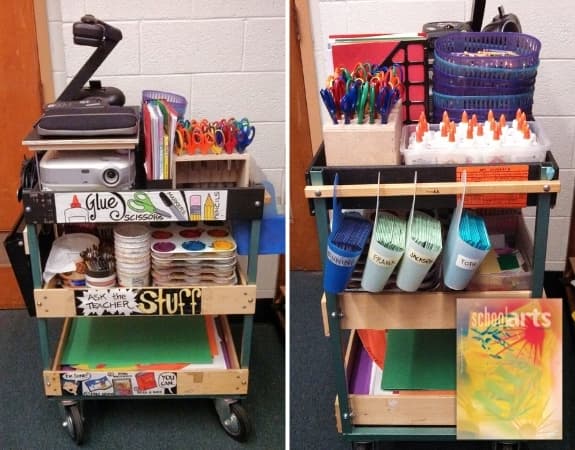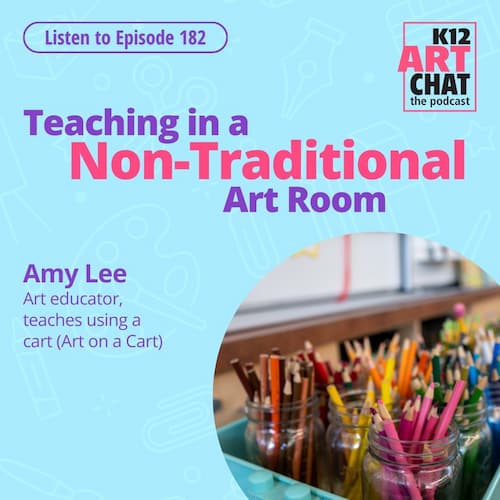Life on the Road, Art on a Cart
It’s an all-too-common fact that some art classrooms are mobile. “Art on a Cart” is something we’re all familiar with but, unless you teach from one, maybe you haven’t really considered it. Well, what if you find yourself teaching art off a cart someday? How do you adjust? Keep reading to gather some timeless advice from the field in SchoolArts magazine.

Every year, I drool over photos of vibrant, organized art rooms on all my favorite blogs, my Pinterest boards—even the pages of this very magazine! Alas, I’m one of many art teachers without a room, who teach from a cart. In fact, I’ve never had a classroom, though I’ve taught for ten years. If I finally had four walls to call my own, I would collapse under the pressure of so much space.
Not that there isn’t pressure being on a cart. You must leave the room clean for the classroom teacher. You must finish your lesson in time to roll off to your next class. You must never forget anything in your supply closet. You must always prepare enough materials. You must always keep your cart clean and organized. Messy classroom or closet? Fine. Messy cart? Never. I have adapted to my miniature classroom, 21 x 28 x 38", to be exact. From this tiny world, the imaginations of more than 500 students are brought to life.
The Top Shelf
The cart itself is the remnants of a wooden cart abandoned in the gym of my school. I transformed it with 6" (15cm) swivel casters to handle thresholds and carpets. It rides like a dream and turns on a dime. I also have a small drying rack on wheels that is pushed by a student helper when it is needed. My cart contains everything I need and nothing I don’t. The top shelf is split into two sections. One side is set up with my equipment and teaching materials. I have an LCD projector stacked on top of a $29 DVD player. A cheap breakfast tray nests on top of this to create a second level. Here sits my document camera, laptop, and a small set of Bluetooth speakers. I find this equipment saves time in the classroom. I can park my cart in front of the classroom’s whiteboard and project images from my computer. On the side of the cart is a collapsible shelf for use with the document camera. We can watch video clips, do smartboard activities, or even listen to music while we are working. I keep a small box with color-coded file folders for each grade level. These hold books or handouts, as well as some free-draw paper and coloring activities, because you never know. The other side holds supplies we use every day: pencils, markers, erasers, scissors, glue, and crayons. I keep eight to ten sets of most supplies in baskets and tubs. This allows me to spread them around the room no matter how the classroom is set up. On the handlebar of this shelf hang sketchbooks for each class for that day. Every student makes a small booklet on the first day of school. We use them all year to take notes, record vocabulary, and sketch, when students finish a project early.
The Middle Shelf
The middle shelf holds other materials and supplies needed for each project. I teach six different lessons at any given time. Paint trays, oil pastels, collage paper, or whatever else is needed that day lives on the middle shelf. Most days, I can make a pit stop at lunch to swap materials if necessary. I also keep cleanup supplies here. We clean up with a wet roll of paper towels stored in an old cookie dough tub.
The Bottom Shelf
The bottom shelf is home to all paper materials. I keep class folders of artworks in progress, visuals, and a stack of placemats. These are just poster board cut in half and recycled from year to year, used to keep students’ desks relatively clean. Students are very respectful of my cart. At the end of class, they turn in papers to the drying rack or the bottom shelf and return supplies to their labeled locations. My supplies are sacred. I label everything bright purple and depend on classroom helpers to do a thorough check of the room before I roll away. My lessons are the same as any other teacher. I just add the time it takes to pass out and pick up everything within our class time. This attempt to save precious work time is a dance that changes with every project. I have found that the cart does not limit our possibilities. It is a challenge that I enjoy. So, take pride fellow traveling art teachers! Roll on!
Bonnie Greene is an art teacher at Southampton Elementary School in Richmond, Virginia.


Comments